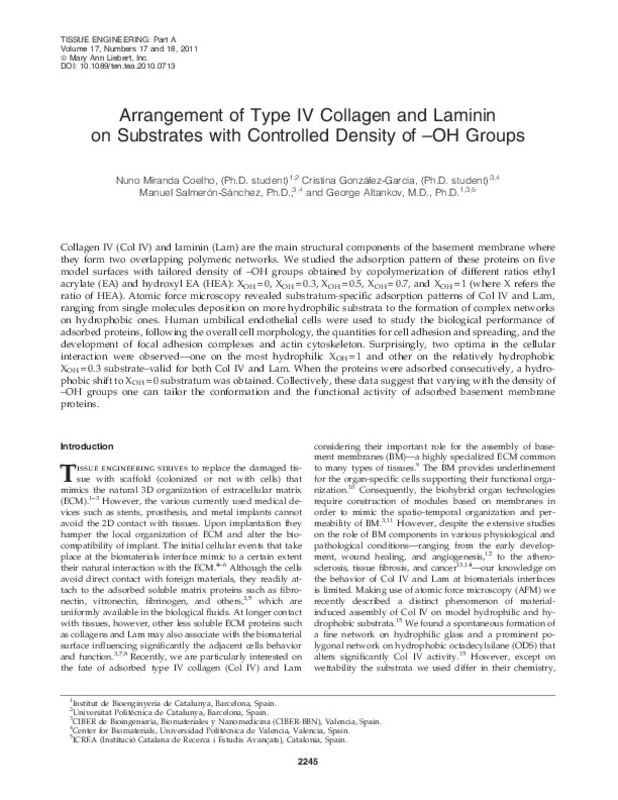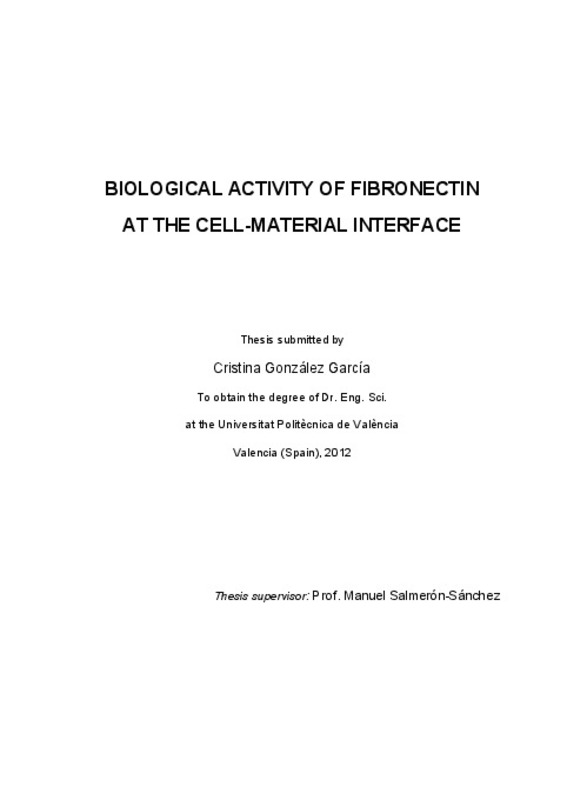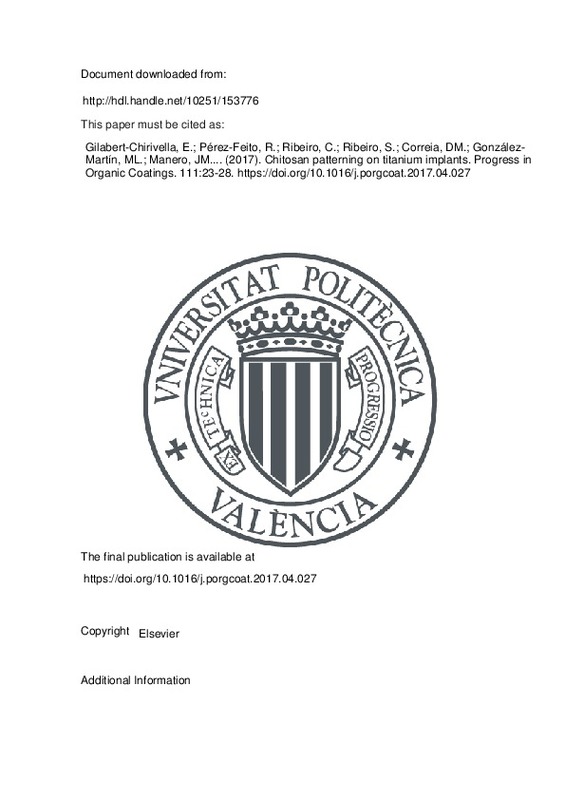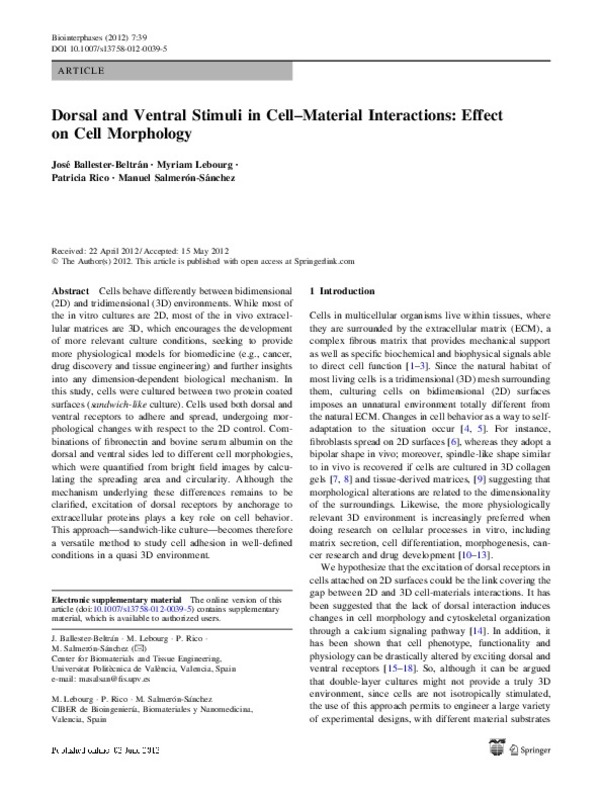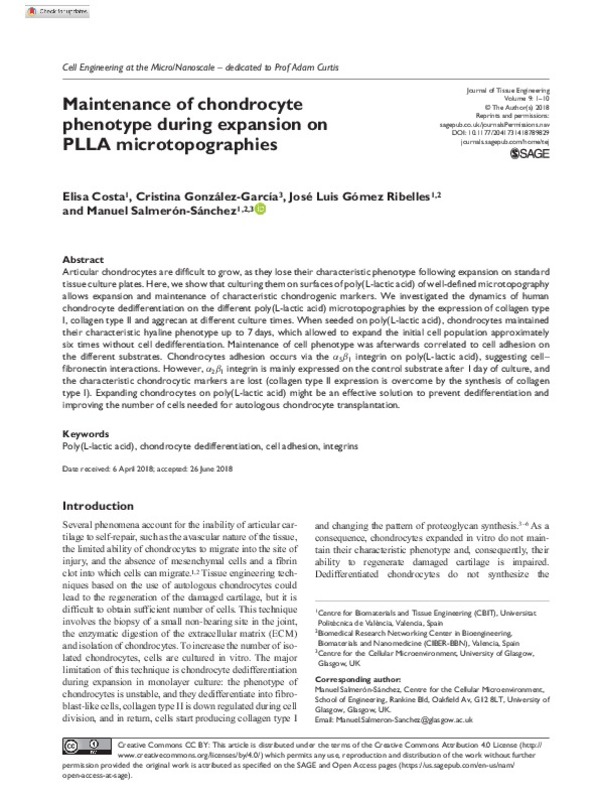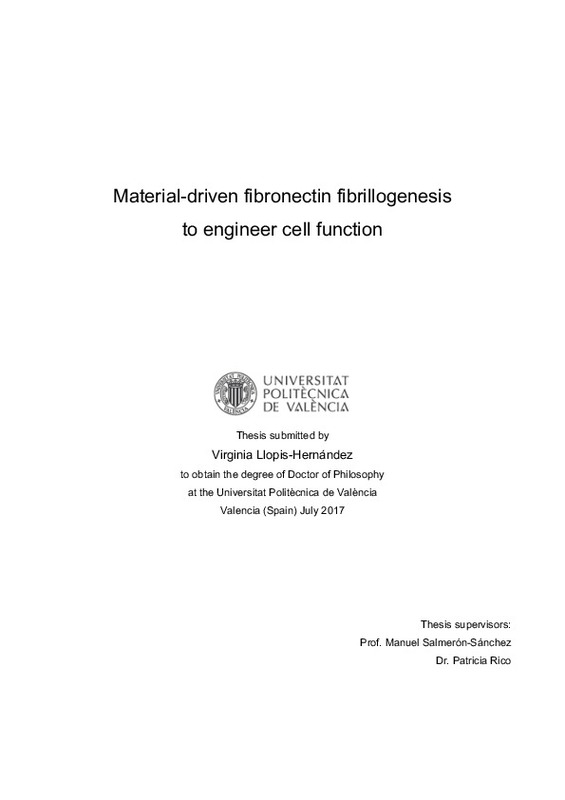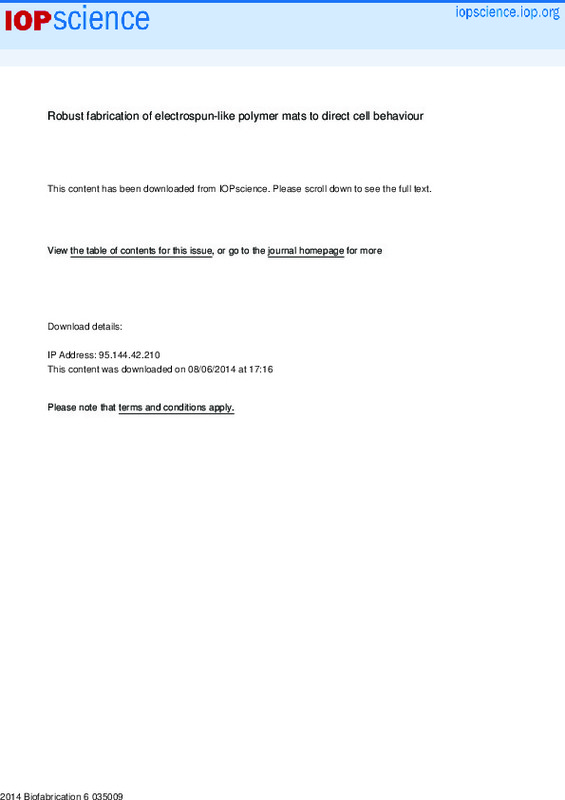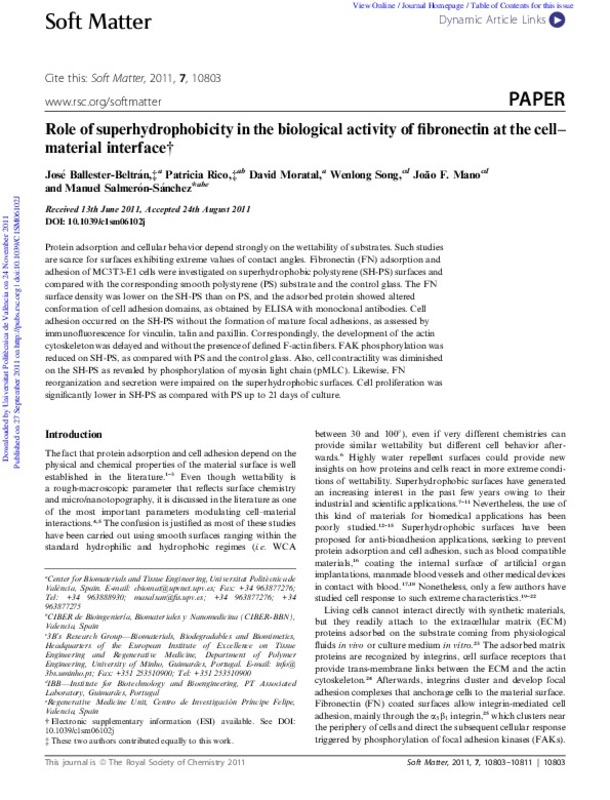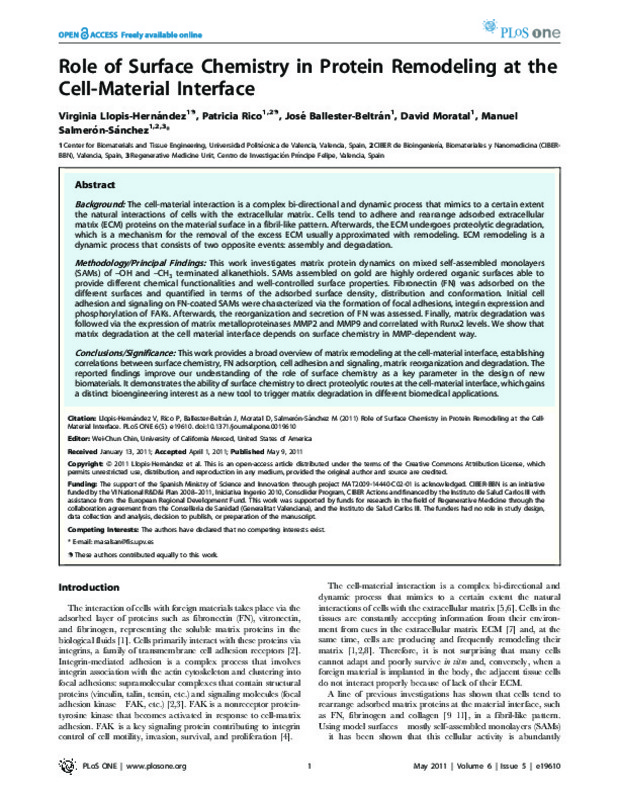

Listar por palabra clave "Cell adhesion"
RiuNet: Repositorio Institucional de la Universidad Politécnica de Valencia
- RiuNet repositorio UPV
- :
- Listar por palabra clave
JavaScript is disabled for your browser. Some features of this site may not work without it.
Buscar en RiuNet
Listar
Mi cuenta
Ayuda RiuNet
Admin. UPV
Listar por palabra clave "Cell adhesion"
Mostrando ítems 1-19 de 19
-
Coelho, Nuno Miranda; González García, Cristina; Salmerón Sánchez, Manuel; Altankov, George (Mary Ann Liebert, 2011)Collagen IV (Col IV) and laminin (Lam) are the main structural components of the basement membrane where they form two overlapping polymeric networks. We studied the adsorption pattern of these proteins on five model ...
-
González García, Cristina (Universitat Politècnica de València, 2012-11-05)Esta tesis aborda la actividad biológica de la fibronectina (FN) como proteína de interfase en la interacción célula-material. La tesis investiga la respuesta de la proteína, en términos de cantidad adsorbida y conformación, ...
-
Soria, Jose Miguel; Sancho-Tello, María; Garcia Esparza, M. Angeles; Mirabet, Vicente; Bagan, Jose Vicente; Monleón Pradas, Manuel; Carda, Carmen (John Wiley & Sons, 2011)[EN] This study is focused on the development of an in vitro hybrid system, consisting in a polymeric biomaterial covered by a dental pulp cellular stroma that acts as a scaffold offering a neurotrophic support for the ...
-
Gilabert-Chirivella, Eduardo; Pérez-Feito, Ricardo; Ribeiro, Clarisse; Ribeiro, Sylvie; Correia, Daniela M.; González-Martín, Maria Luisa; Manero, Jose Maria; Lanceros-Mendez, S.; Gallego-Ferrer, Gloria; Gómez Ribelles, José Luís (Elsevier, 2017-10)[EN] Titanium and its alloys are widely used in medical implants because of their excellent properties. However, bacterial infection is a frequent cause of titanium-based implant failure and also compromises its osseointegration. ...
-
MNATSAKANYAN, HAYK; Rico Tortosa, Patricia María; Grigoriou, Eleni; Maturana Candelas, Aarón; Rodrigo Navarro, Aleixandre; Salmerón Sánchez, Manuel; Sabater i Serra, Roser (American Chemical Society, 2015-08-19)Fibronectin fibrillogenesis is the physiological process by which cells elaborate a fibrous FN matrix. Poly(ethyl acrylate), PEA, has been described to induce a similar process upon simple adsorption of fibronectin (FN) ...
-
Panadero Pérez, Juan Alberto; Lanceros-Méndez, S.; Gómez Ribelles, José Luís (Elsevier, 2016)[EN] The importance of biomechanical cues in chondrogenesis is well known. This paper reviews the existing literature on the effect of mechanical stimulation on chondrogenic differentiation of mesenchymal stem cells in ...
-
Ballester Beltrán, José; Lebourg, Myriam Madeleine; Rico Tortosa, Patricia María; Salmerón Sánchez, Manuel (American Vacuum Society, 2012-06)Cells behave differently between bidimensional (2D) and tridimensional (3D) environments. While most of the in vitro cultures are 2D, most of the in vivo extracellular matrices are 3D, which encourages the development of ...
-
Gamboa Martínez, Tatiana Carolina; Gómez Ribelles, José Luís; Gallego-Ferrer, Gloria (SAGE Publications (UK and US), 2011-09)A hybrid scaffold was obtained by the deposition of a thin network of submicron fibrin fibrils on the microporous walls of a macroporous poly(L-lactide) (PLLA) three-dimensional structure. The fibrin coating is homogeneous ...
-
Gugutkov, Dencho; González García, Cristina; Altankov, George; Salmerón Sánchez, Manuel (SAGE Publications, 2011)[EN] Fibrinogen (FG) adsorption on surfaces with controlled fraction of -OH groups was investigated with AFM and correlated to the initial interaction of primary endothelial cells (HUVEC). The -OH content was tailored ...
-
Perez Garnes, Manuel; González García, Cristina; Moratal Pérez, David; Rico Tortosa, Patricia María; Salmerón Sánchez, Manuel (Wichtig Editore, 2011-02-04)[EN] Purpose: It is known that surface nanotopography influences cell adhesion and differentiation. Our aim is to analyze the effect of nanoscale topography on fibronectin adsorption and, afterwards, on cell adhesion in ...
-
Morata-Martínez, Miranda; Sprott, Mark R.; Antolinos-Turpín, Carmen M.; Salmerón Sánchez, Manuel; Gallego-Ferrer, Gloria (2023-04-17)[EN] Fibronectin (FN) mediates cell-material interactions during events such as tissue repair, and therefore the biomimetic modeling of this protein in vitro benefits regeneration. The nature of the interface is crucial ...
-
Saadeddin Saadeddin, Anas; Rodrigo Navarro, Aleixandre; Monedero, Vicente; Rico Tortosa, Patricia María; Moratal Pérez, David; González-Martín, María Luisa; Navarro, David; García, Andrés J.; Salmerón Sánchez, Manuel (Wiley, 2013-09)Lactococcus lactis is modified to express a fibronectin fragment (FNIII₇₋₁₀) as a membrane protein. This interphase, based on a living system, can be further exploited to provide spatio-temporal ...
-
Costa Martínez, Elisa; González García, Cristina; Gómez Ribelles, José Luís; Salmerón Sánchez, Manuel (SAGE Publications, 2018-08-06)[EN] Articular chondrocytes are difficult to grow, as they lose their characteristic phenotype following expansion on standard tissue culture plates. Here, we show that culturing them on surfaces of poly(L-lactic acid) of ...
-
Llopis Hernández, Virginia (Universitat Politècnica de València, 2017-11-03)This thesis ventures with the extracellular matrix protein (ECM) fibronectin (FN) as an interface protein in the interaction between cells and materials to design microenvironment for future use in tissue engineering. It ...
-
Ballester Beltrán, José; Lebourg., Myriam Madeleine; Capella Monsonís, Héctor; Díaz Lantada, Andrés; Salmerón Sánchez, Manuel (IOP Publishing: Hybrid Open Access, 2014-09)Currently, cell culture systems that include nanoscale topography are widely used in order to provide cells additional cues closer to the in vivo environment, seeking to mimic the natural extracellular matrix. Electrospinning ...
-
Mukhatyar, Vivek J.; Salmerón Sánchez, Manuel; Rudra, Soumon; Mukhopadaya, Shoumit; Barker, Thomas H.; Garcia, Andres J.; Bellamkonda, Ravi V. (Elsevier, 2011)Bridging of long peripheral nerve gaps remains a significant clinical challenge. Electrospun nanofibers have been used to direct and enhance neurite extension in vitro and in vivo. While it is well established that oriented ...
-
Salmerón Sánchez, Manuel; Rico Tortosa, Patricia María; Moratal Pérez, David; Lee, Ted T.; Schwarzbauer, Jean E.; Garcia, Andres J. (Elsevier, 2011)Fibronectin (FN) is a ubiquitous extracellular matrix protein (ECM) protein that is organized into fibrillar networks by cells through an integrin-mediated process that involves contractile forces. This assembly allows for ...
-
Ballester Beltrán, José; Rico Tortosa, Patricia María; Moratal Pérez, David; Song, Wenlong; Mano, Joao F; Salmerón Sánchez, Manuel (Royal Society of Chemistry, 2011)Protein adsorption and cellular behavior depend strongly on the wettability of substrates. Such studies are scarce for surfaces exhibiting extreme values of contact angles. Fibronectin (FN) adsorption and adhesion of ...
-
Llopis Hernández, Virginia; Rico Tortosa, Patricia María; Ballester Beltrán, José; Moratal Pérez, David; Salmerón Sánchez, Manuel (Public Library of Science, 2011)Background: The cell-material interaction is a complex bi-directional and dynamic process that mimics to a certain extent the natural interactions of cells with the extracellular matrix. Cells tend to adhere and rearrange ...
Mostrando ítems 1-19 de 19

Universitat Politècnica de València. Unidad de Documentación Científica de la Biblioteca (+34) 96 387 70 85 · RiuNet@bib.upv.es


